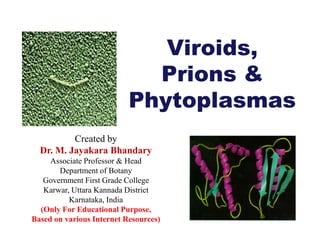
Viroids, Prions and Mycoplasma
- 1. Viroids, Prions & Phytoplasmas Created by Dr. M. Jayakara Bhandary Associate Professor & Head Department of Botany Government First Grade College Karwar, Uttara Kannada District Karnataka, India (Only For Educational Purpose, Based on various Internet Resources)
- 2. Viroids • Circular, ss RNA molecules of low mol. Wt. that mainly cause diseases in plants. • Smallest known infectious agents. • Don’t code for any proteins– disrupt protein synthesis mechanisms in plants. • Discovered by T. O. Diener (1971), associated with Potato Spindle Disease • 1,00,000 – 1,40,000 d in size • No protein coat like viruses • 2 groups - Pospiviroidae (Ex. Potato Spindle Tuber Viroid, PSTVd) & Avsunviroidae (Ex. Avocado SunBlotchViroiD ASBVd).
- 3. Structure • Circular ss RNA molecule with double stranded regions due to complementary base pairing. • 250-400 nucleotides Electron microscopic picture of potato • Appears like a Rod spindle tuber viroid (PSTVd) (Courtesy Dr. G. Klotz)
- 5. Multiplication • Viroids (RNA) multiply inside the nucleus of infected plant cell by ‘Rolling Circle’ mechanism, using the host enzymes. • Produce long, multimeric strands of RNA which are cut into monomers, each monomer then joined to form an individual circular viroid. • After replication, the progeny RNAs move to neighboring healthy cells through the connecting plasmodesmata or to distant parts of the plant via the phloem.
- 7. Pathogenesis • Viroids multiply inside host cells and cause diseases by ’RNA interference’ (RNAi). • RNAi is a mechanism that degrades double-stranded RNAs (dsRNA). • Short lengths of Viroid RNA base pair with complementary host mRNA to form dsRNAs that are then degraded. • Destroying the host mRNAs affects synthesis of proteins by host cell.
- 8. Viroid Diseases • Potato Spindle Tuber : Spindle or elongated tubers, stunting of growth. Chrysanthemum stunt Disease (CSVd), Citrus exocortis (CEVd), Coconut cadang-cadang disease (CCCVd), and Avocado sunblotch disease (ASBVd).
- 9. Coconut Cadang Cadang Disease • Common in Coconut and Oil Palm • leaf spots, reduced leaflets, reduced crown, stunted growth, • Reduction in number and size of nuts • Finally death of infected palms. • Common in Philippines
- 10. Prions • Infectious proteins – proteins which cause disesae • Discovered by Prusiner in 1982 in Scrapie (neurological disease of sheep) • Prusiner won the Nobel Prize in Physiology or Medicine in 1997 • Misfolded / abnormally folded proteins in animals which are pathogenic. Normally folded versions are non-pathogenic. • Causes the similar proteins to also misfold
- 11. Prion Diseases • Prions are responsible for the Transimissible Spongiform Encephalopathy in Mammals, including Bovine Spongiform Encephalopathy (BSE, also known as "mad cow disease") in Cattle and Creutzfeldt-Jakob Disease (CJD) in humans. • All known prion diseases affect the structure of the Brain or other Neural tissue and all are currently untreatable and universally fatal.
- 13. Prion Reproduction • When a prion enters a healthy organism, it induces existing, properly folded normal proteins to convert into the disease-associated, prion form. • The normal form of the protein is called PrPC, while the infectious (prion) form is called PrPSc • These newly formed prions can then go on to convert more proteins themselves; this triggers a chain reaction that produces large amounts of the prion form. • Prions cause other similar proteins to also misfold lose function, cause disease
- 14. A) Normal Protein b) infectious protein
- 17. PHYTOPLASMAS (PLANT MYCOPLASMA) • Phytoplasmas are prokaryotes lacking cell walls and are obligate parasites of plant phloem tissue and transmitting insects (vectors). • They are currently classified in the class Mollicutes. • Phytoplasmas are associated with plant diseases, and are known to cause more than 600 diseases in several hundred plant species. • Phytoplasmas are transmitted from plant to plant by insect vectors, mainly leafhoppers and psyllids. . • They were first discovered by scientists in 1967 and were named mycoplasma-like organisms or MLOs, because they physically resembled mycoplasmas. • The organisms were renamed phytoplasmas in 1994. They cannot be cultured in vitro in cell-free media.
- 18. Mycoplasmas • A genus of parasitic or saprophytic bacteria that lack a cell wall, pathogenic in animals. • Several species are pathogenic in humans, including M. pneumoniae, which is an important cause of pneumonia and other respiratory disorders, and M. genitalium, which is believed to be involved in pelvic inflammatory diseases. • The name Mycoplasma, from the Greek mykes (fungus) and plasma (formed), was first used by A. B. Frank in 1889. • He thought it was a fungus, due to fungus-like characteristics. • They are also called Pleuropneumonia-Like Organisms (PPLO).
- 19. Structure of Phytoplasma • Phytoplasmas lack cell walls and instead are bound by a triple layered Membrane. • The typical phytoplasma exhibits a pleiomorphic or filamentous shape. • less than 1 micrometer in diameter. Like other prokaryotes, DNA is free in the cytoplasm.
- 21. Electron micrographs of Phytoplasma
- 22. Infection & Multiplication • Phytoplasmas are transmitted from plant to plant by insect vectors, mainly leafhoppers and psyllids. • They multiply in the hemolymph and the salivary glands of insects. • The insect vectors introduce phytoplasmas along with salivary fluids into the phloem of a new host plant.
- 24. General Symptoms • yellowing or reddening of the leaves, • shortening of the internodes with stunted growth, smaller leaves, • excessive proliferation of shoots resulting in a witches' broom • Phyllody (production of leaf-like structures in place of flowers) • Virescence (development of green flowers), sterile flowers, • necrosis of the phloem tissues, • dieback of the branches of woody plants, • general decline and death of the plant.
- 25. Control Measures • Breeding and planting of disease resistance varieties of crops. • by the control of the insect vector. • Cryotherapy and Tissue culture propagation of infected plants. • Treatment with the antibiotic ‘Tetracycline’
